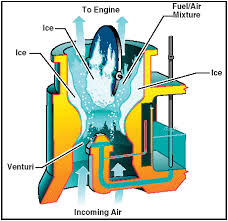description and diagram of Carburetor system
at the bottom of this link at www.free online private pilot ground school

As the snows of winter vanish from airport landscapes, pilots cheer the disappearance of snowdrift hazards, icy patches on runways, and morning frost on aircraft. But another ice hazard becomes more likely when temperatures climb.
Think of it as the ice of summer, but whatever you do, don’t ignore carburetor icing as a warm-weather flying hazard. Every year, carb ice foils some unwary pilots, even when temperatures soar toward 100 degrees Fahrenheit! The problem, explains Chapter 6 of the Pilot’s Handbook of Aeronautical Knowledge (6-7), is “the effect of fuel vaporization and the decrease in air pressure in the venturi, which causes a sharp temperature drop in the carburetor. If water vapor in the air condenses when the carburetor temperature is at or below freezing, ice may form on internal surfaces of the carburetor, including the throttle valve.” Scrutinize the chart accompanying the chapter; it depicts temperature-humidity combinations that pose the highest carb icing risks.
“Obviously, awareness of carb icing is especially important in the training environment, in which much time is spent practicing low-throttle exercises such as flight at minimum controllable airspeed, landing approaches, and simulated engine failure emergencies,” noted the Aug. 22, 2002, Training Tip that also discussed proper technique for applying carb heat.
Pilots must also understand a drawback of carb heat use: It robs the engine of power. So remove carb heat fully and promptly when adding throttle, for instance when commencing a go-around. How much power does carb heat sap from the engine? Next time you operate the carb heat during an engine run-up, or when reducing power to begin a practice maneuver, note the specific rpm drop. It can be considerable.
What else can you do in flight to improve your carb-ice risk awareness? Apply carb heat on occasion during cruise flight. Note if your power setting is higher after you remove it.
Another tip: “Develop the habit of keeping an eye on the outside air temperature along with rpm or manifold pressure gauges, while tuning the ear to engine smoothness,” wrote Dan Namowitz in the October 2009 Flight Training “Accident Analysis” column. Every detail matters because “carb heat may not save the day if added too late or too low.”
the text is from a recent AOPA article on epilot if you are not signed up for it - you should, it is a wealth of information https://flighttraining.aopa.org/
